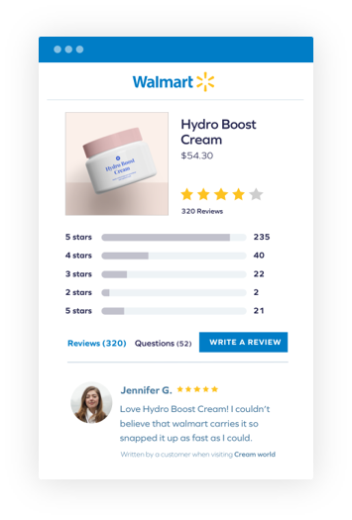As community becomes more important to brand building, more brands and marketers are coming to understand the importance of user-generated content. To simplify the concept, Glossy spoke to experts in the field, who explained everything from the basics of UGC to the ways and reasons UGC benefits brands today.
First things first, what is UGC?
User-generated content is exactly what the term suggests. According to William Gasner, co-founder and CMO at Stack Influence, a platform that helps brands generate UGC, the term means content created by a real person (and not AI). Though this generally means your “everyday, average person,” theoretically speaking, a celebrity could create UGC, too — because it comes down to the creator simply being human, Gasner said.
Danna Rabin, gm of UGC at Yotpo, a marketing platform that helps brands gather reviews from customers, expanded upon that definition, describing UGC as “any type of content generated [by users] in the form of text, video, images, reviews, blog posts or social media posts.” If it is created by an individual, and not a business, it is UGC, she said.
What is a UGC creator, and how does that differ from a traditional creator?
On social media, perhaps you’ve come across a profile of a self-described UGC creator. This is akin to being a fledgling influencer, of sorts. It is a person signifying to the world — and brands — that they are open to creating promotional content for products. Defining oneself this way, Gasner said, is “signifying that [you are] trying to either make a living doing this or make extra money doing this, or that this is something [you are] passionate about.”
When it comes to traditional influencer marketing, there are bracketed tiers used to categorize creators based on their followings, Gasner noted. The standard taxonomy is as such: A creator with 1,000-10,000 followers is considered a nano-influencer; 10,000-100,000 is a micro-influencer; 100,000-1 million is a macro-influencer; and anyone with over 1 million followers is a mega-influencer.
Stack Influence primarily focuses on pairing UGC creators with unpaid opportunities. In other words, the creator receives a product and, in exchange, posts about it on social.
Once creators reach a certain number of followers, they typically do not participate in unpaid opportunities like this — as more paid opportunities become available.

“[Often] people start out creating content in exchange for free products, which is what our platform specializes in,” Gasner said, calling it the “gateway” to the influencer world. “Get your feet wet and build up what we call an ‘influencer resume’ of a bunch of different content, showing your effectiveness working with brands. Then, you can leverage that to become a larger creator or influencer and get more paid deals,” he said of the process.
Of course, there’s a fine line between talking about a product you genuinely love that is aligned with your actual passions and hawking anything you can get for free.
“If you’re interested in rock climbing and you post about rock climbing all the time, and someone offers you a brand deal for rock climbing shoes or chalk, and you promote it, whether it’s for a free product or a paid opportunity, that is true influence,” he said. “That’s true authenticity, and it’s trustworthy — because your followers know that maybe you are not a professional in this space, but you’re at least passionate about it.”
Rabin pointed out another distinction: A full-time, career content creator is likely also focused on building community in a way a UGC creator may not yet be doing or be able to do. “Influencers actively invest in creating a community around a topic or a theme — around the content they are sharing — whether it’s on a blog or an Instagram page.”
Why is UGC important for brands?
“UGC is a more authentic and trustworthy form of content, as opposed to professional photography [which is hyper-] curated or AI-generated content,” Gasner said. It is a bridge from word-of-mouth and helps products feel more accessible to potential customers than traditional advertising imagery, he added.
“Showing real, non-model-esque people utilizing a product makes [that product] more accessible to a larger consumer base. It makes it more real,” he said. “It makes it like, ‘I don’t have to be this model or this celebrity to look this good.'”
In addition to being a way to garner authentic content, UGC is also cost-effective — often, the only cost is that of the featured product itself and the shipping to get it to the user. Particularly if they are anonymized, Rabin said, brands can use image and video reviews culled from Yotpo for free in marketing materials.

Finally, UGC generally garners high engagement, Rabin said. “UGC [encourages] customers to engage: They are actively participating in the brand experience themselves and sharing their experience,” she said. “As a result, they feel like they are part of the brand rather than like [the brand] is talking to them. … It builds community around products.”
At Yotpo, Rabin has seen firsthand how reviews — particularly those with images — can even help brands decrease returns by making it possible for customers to see how a color cosmetic shade — or a shirt — looks on someone with a similar skin tone or body type. Not only can these reviews generate more content, but they can generate actionable feedback, too, she said.




